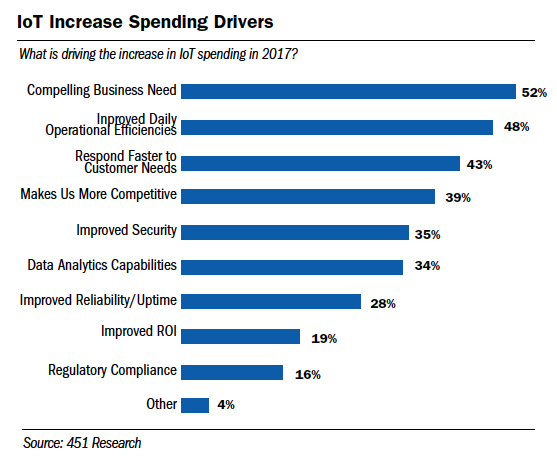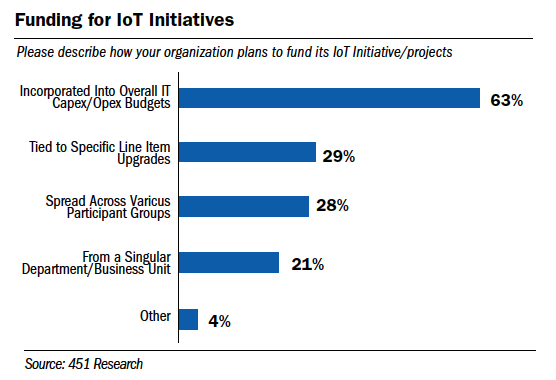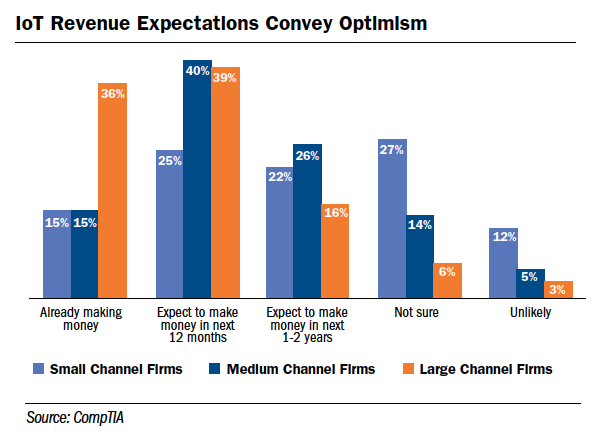Points Ahead – Partner opportunities open up in IoT
By: Tara Seals
![[excerpt from ChannelVision May-June 2017]](https://channelvisionmag.com/wp-content/uploads/2017/06/CV_MayJune-2017_Cover_300.png)
The enterprise market for the Internet of things (IoT) is buzzing, with adoption continuing apace. While it’s a nascent space for channel partners, there are increasing opportunities for them to participate in the growth.
According to a recent study from Aruba Networks, IoT adoption in several sectors is widespread – exceeding 70 percent in the enterprise workplace, for example, and more than 60 percent in the industrial sector – and mass adoption is expected by 2019. Overall, more than half of businesses have implemented some kind of IoT solution (and another 32 percent plan to implement it within the next two years).
Many of the respondents reported that IoT returns higher ROI or greater innovation than anticipated. Post-adoption, 32 percent of executives said that they realized profit increases. Similarly, 29 percent of executives expected business efficiency improvements, whereas 46 percent experienced efficiency gains. Twenty-eight percent expected innovation increases, and 48 percent reported more innovation. More than three quarters say IoT in the workplace has improved the effectiveness of their IT team.
About 72 percent of companies surveyed have implemented a smart workplace IoT strategy for productivity and efficiency, from air conditioning and lighting systems (56 percent) to personal mobile devices (51 percent).
When it comes to verticals, in the industrial sector, 62 percent of respondents have implemented IoT, with monitoring and maintaining industrial functions identified as the most prevalent use case. Use of IP-based surveillance cameras for security is still in its infancy, with only 6 percent having implemented it. However, when asked about future implementations, surveillance jumped to 32 percent. Sector-wide, 83 percent report increased business efficiency from IoT.

In healthcare, 60 percent of organizations globally have introduced IoT devices into their facilities, primarily to improve patient monitoring. Eight in 10 healthcare organizations reported increases in IoT-related innovation and 73 percent reported cost savings.
Lagging behind these sectors are retail, with 49 percent using IoT technology, and government, with 42 percent of municipalities deploying IoT devices.
SuppliersTap Partners
With such strong adoption at their backs, providers are starting to view IoT as something that partners can sell, and some are putting support resources around it. For instance, earlier this year, the AT&T Partner Exchange launched a collection of resources to help make it easier for solution providers to navigate the possibilities of IoT with their customers.
“IoT is already connecting manufacturing equipment, health monitors, vehicle fleets and much more to the Internet,” said Sue Galvanek, vice president, marketing, pricing and product solutions, AT&T Partner Exchange. “Last year, AT&T Partner Exchange launched our IoT platform, AT&T Control Center, to the channel. We’re building on that success by bringing the right blend of products, tools and resources to help solution providers unlock the full potential of IoT.”
Resources include “A Channel Executive’s Guide to IoT,” which offers partners insight into current and emerging trends and guidance on how to prepare their own IoT strategy. It outlines IoT building blocks, success stories and resources available. AT&T also has collaborated with Infusion Partners to create the IoT Readiness Assessment, to help solution providers understand where to begin when developing an IoT offering. The survey evaluates a solution providers’ market focus, investment level, offer strategy and business plan to assess their IoT readiness and identify potential areas for IoT growth.
“Understanding how your company can maximize the potential of IoT is a major hurdle,” said Brad Sander, president, Infusion Partners. “The IoT Readiness Assessment helps solution providers discover opportunities to empower growth and innovation through IoT.”
The AT&T IoT Starter Kit is also available to AT&T Partner Exchange solution providers and offers them hands-on experience to rapidly prototype their own IoT solution. The all-in-one kit comes ready with the tools and services to trial new offers to meet customer needs.
“IoT will continue to impact the way we live and work. Connected devices produce rich data that helps companies better respond and understand their customers’ needs,” said Robert Senatore, president and chief operating officer, Data2Go Wireless. “Those who want to seize these opportunities need the right tools. AT&T Partner Exchange is helping us do just that.”

Some IT solution providers are carving out unique niches in the IoT market. For example, Presidio Inc. provides a fleet management solution for a Texas school district, allowing administrators to track student safety and bus routes across 625 square miles. Dimension Data empowered the Tour de France with a range of IoT applications – including custom network transported sensor information from bicycles – to deepen fan engagement. Axians helped to develop an in-building IoT lighting system that enabled a European energy network company to slash its energy consumption by up to 70 percent; and Impetus Technologies created a factory-floor IoT system that helped a customer improve its manufacturing processes and reduce the volume of product defects.
Distributors Ramp Up
Distributors are leading the way on this as well. Tech Data, for instance, officially launched its IoT solutions practice in 2016 to target specific verticals such as smart spaces, transportation/logistics, manufacturing and retail. It recently expanded its SmartForce IoT portfolio through a strategic partnership with Propel GPS. Propel GPS, a Virginia-based solution provider, also with an office in North Carolina, offers an IoT/ cloud-based platform for assets of all types, with vertical market applications in commercial vehicle fleet, transportation, utilities and construction equipment management.
The solution delivers asset and temperature monitoring, along-route virtual geographic boundaries and fleet tracking. The software supports full reporting capabilities by vehicle, fleet, driver or team, allowing for a reduction in cost and an increase in productivity. From the truck to the back office, Propel GPS can be used to monitor all metrics pertaining to truck maintenance, driver performance and the protection of the contents of the trailer – including the key element of driver hours through e-Log reporting to meet legal requirements.
“We founded Propel GPS as a cloud-based IoT business five years ago as a platform to positively disrupt the status quo asset management and sensor service providers,” said Rick Burtner, CEO, Propel GPS. “With our cloud platform, customers have real-time access to their data and don’t have to worry about their legacy infrastructure in the transportation, telematics, agriculture and oil and gas markets. Partnering with Tech Data is an example of this philosophy, where we can synergize our two companies’ respective strengths to create and build innovative solutions as a go-to provider for our combined customers.”
Avnet also is eyeing IoT for partners. Available to the channel via Avnet’s Technology Solutions business, relayr’s 5-4-3 Innovation Acceleration process is geared to dramatically shorten partners’ customers’ development time for IoT solutions, transforming an idea into a functioning IoT prototype in as little as five weeks, the company said. This is offered in three focused stages. The Kickstart stage lasts five days and includes a hands-on workshop that enables customers to identify three leading ideas and create an implementation roadmap for IoT solutions specific to their enterprise. The workshops can be led by IoT experts from relayr or certified partners.

In the Accelerate phase, over four weeks, the selected idea from the Kickstart phase is rapidly developed and tested to create a working prototype. IoT experts from Avnet and relayr are available to help partners throughout the prototyping process.
And finally, in the Traction phase, spanning 3 months, the prototype is fully tested, giving the customer a real-life use case to provide critical insights for mass production and rollout planning, and accelerate their time to market.
“relayr’s 5-4-3 Innovation Acceleration process addresses the greatest challenge many of our partners are facing – how to help customers initiate an IoT project,” said Colin Blair, vice president of data analytics and IoT solutions, Avnet Technology Solutions, Americas. “Our partners will be able to use this service to fast track IoT solutions – within one business quarter – that can easily be integrated with their customers’ existing technology environments. Working together, Avnet and relayr will give partners the foundation they need to help their customers create IoT solutions from simple experimentation to full-scale deployments.”
Ancillary Opportunities
Above and beyond the IoT solutions themselves, channel partners also have the opportunity to bring their expertise as trusted advisors to the mix, layering on additional solutions.
“The channel is making significant progress with monetizing the IoT opportunity and, unlike past years, view themselves as strong profitability candidates,” said Seth Robinson, senior director of technology analysis at CompTIA.
Stumbling blocks to widespread IoT deployments include concerns about costs and return on investment; technical hurdles; and liability, privacy and other regulatory matters. As a result, consulting is currently the most popular IoT channel offering, with 40 percent of companies offering something in this space. The next most popular offering is security, provided by 36 percent of firms. Analytics, managed services, custom app development, reselling and infrastructure services are offered by between 30 percent and 35 percent of companies.
“First, the complexity of IoT projects is beyond what many companies can handle internally, especially on the SMB end of the spectrum,” Robinson explained. “Second, many areas of IoT are essentially extensions of the skills and lines of business that solution providers already have.”
Security might be the fastestgrowing ancillary arena. Aruba’s aforementioned global IoT study earlier this year revealed that 84 percent have already experienced a security breach as a result of implementing IoT. Out of those, 49 percent dealt with malware, 38 percent have been the target of spyware, 30 percent experienced phishing and 26 percent suffered from a DDoS attack.
Overall things look bright for channel partners: CompTIA’s Internet of Things Trends and Opportunities report found that 23 percent of channel companies surveyed say they’ve already made money from IoT offerings, compared to just 8 percent in 2015. Looking forward, one-third of channel firms expect to make money from IoT in the next 12 months.
This digital article is sponsored by: Telegration
VIEW ARTICLE
VIEW FULL ISSUE
About ChannelVision Magazine:
ChannelVision is a bi-monthly digital and print magazine, read by channel partners selling all manner of voice, data, access, managed and business services (both on premise and “in the cloud”), as well as, technology, gear, and equipment. ChannelVision is a highly focused and efficient way for service providers, hardware, and software companies to reach experienced channel partners targeting the small/medium business space. Serving a controlled circulation of providers and indirect distributors of communications, network, IT and cloud-based business services, ChannelVision is telecom’s gateway perspective on how to adapt, what to sell, and how to sell it.











